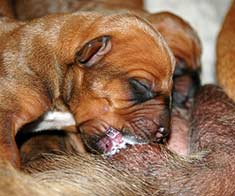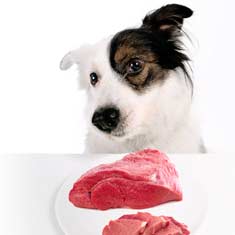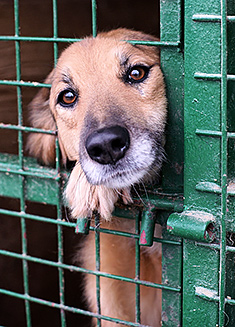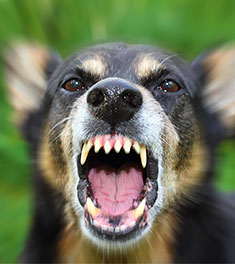How Old is Your Dog?
There are at least a couple of ways to look at the question of how old your dog is. For many dogs, like many humans, age is just a number, and it is more relevant to look at quality of life. At other times, it may be important to figure out your dog's chronological age for purposes of health care, breeding, or choosing the proper formulation of food. Lastly, many people seem preoccupied with telling how old their dog would be in "people years."
Estimating Your Puppy's Chronological Age
If you have taken in a new dog and want to determine how old he or she might be, there are certain age-related physical changes that will help you, particularly during the puppy years.
The most important indicator of age is the dog's teeth. Baby teeth begin to come in at about one month of age. Between two and five months, the dog's front permanent teeth will begin replacing the baby teeth. Canines come in next, during the dog's fifth month. The permanent molars come in, starting from the front, at about four months, and are completely in by seven months.
After about a year or two, a dog's teeth will begin to lose their pearly whiteness and will develop some yellowing. At three to four years, tartar begins to appear, making the teeth appear darker still. The teeth begin to become more blunt with normal wear and tear, losing their sharp points. A very senior dog may begin to lose teeth due to decay. However, keep in mind that a dog who has received dental cleanings or one who regularly chews bones designed for dental health may keep his or her teeth looking like those of a very young dog well into middle or old age.
Determining Quality of Life
Assuming you have had your senior dog for awhile, you are the one in the best position to determine his or her quality of life. Some dogs are more sedate by nature while others are more exuberant and active.
When you are assessing your dog's quality of life, what you are really looking for are changes in how the dog acts over time. For example, if your dog is active in agility work for several years, but suddenly loses interest in competing, you will notice it as a change in behavior and will likely seek out veterinary care. It may be that your dog is suffering from arthritis or another problem that makes it hard for him to compete any longer without medication or assisance devices.
However, some changes are much more subtle, especially if they come on gradually. In the above example, your dog may still want to compete in agility, but may have lost a few seconds off of his or her time. Or maybe he or she avoids a certain modality like weave poles, but still enjoys the teeter-totter and the tunnel.
If your dog is not involved in an organized activity or competitive sport, it may be even more difficult to notice changes in his or her behavior. And the change may be so welcome that you don't attribute it to anything other than the dog finally listening to you. A dog who spends 10 years jumping up on you when you come home from work and then suddenly begins greeting you at the door with all four feet solidly planted on the floor may be cause for great rejoicing at your house. However, it is a change that could indicate the dog is beginning to have aches and pains associated with advancing age.
Your dog may begin to have trouble getting up on the furniture or standing up after he or she has been sleeping for awhile. Maybe car rides are no longer as exciting because it's so hard to get into and out of the car, or even to stay sure-footed while the care is in motion. Perhaps the dog avoids steps or begins tripping over a door stoop upon entering or leaving your home.
All of the problems mentioned above indicate that your dog may be showing signs of age-related joint degeneration. The cartilage in the dog's joints begins to wear away as the dog ages, eventually causing arthritic pain. Previous injuries to the joints accelerate the process, making even young dogs susceptible to joint pain.
The best defense against developing joint pain is to keep your dog as active as possible, taking short walks and engaging in less stressful activities every day. Swimming is great for dogs with joint problems because it places so little stress on the joints. (However, top heavy dogs like French Bulldogs should never be allowed near water, as their body structure does not allow them to stay afloat.)
Other age-related changes
Another age-related decline you may notice is your dog's stamina. With age, the dog's heart valves begin to deteriorate, allowing blood to back up into the lungs. The dog's heart muscle also begins to pump less efficiently. These two major changes combine to take away your dog's ability to go on and on like the Energizer Bunny.
You will likely notice that your dog begins to enjoy longer naps and needs breaks between activities. In the past, the dog may have accompanied you on a run, then been ready immediately to chase a tennis ball or go to the dog park. With age, the dog may only want to complete half of the run or may need to sleep for awhile before being interested in the tennis ball or dog park.
Your dog's metabolism begins to slow down, meaning that you might want to switch to a dog food designed for senior dogs or at least cut down on the amount you are feeding. However, make sure you are still providing essential oils, as the coat and skin become thin and brittle with age. Omega-3 and Omega-6 fatty acids such as those found in fish oils can help condition your dog's coat well into old age.
Your dog's vision and hearing may begin to decline as the eye's lenses become cloudy and the tiny hairs inside the ears which focus sound are lost.
When is it time to put a dog down?
Assuming you have unlimited funds to pay for the best and brightest technology to keep your dog alive, the question often comes down to whether or not treatment will enhance your dog's quality of life. Your vet can only give you estimates as to what a "typical" dog's reaction will be to any specific treatment.
The most valuable input you will receive in making the decision is from your dog. Based on some of the quality of life indicators presented above, you may be able to tell when it is time.
The final decision, although never easy, can often be made by simply looking at the dog's eyes. If they are bright, your dog may still be enjoying his or life. However, if they look droopy or are excessively bloodshot, it may be time to take the final journey.
How old is my dog in human years?
We've all heard the old adage about one dog year being the same as seven human years. As an overly simplified rule of thumb, this is an adequate measure. However, to get a more precise idea of how your dog's age relates to your age, you must take into account the dog's size.
During the first two years of life, most breeds age at about the same rate, ending the period at an age most similar to a young adult human, about age 24. The chart below shows equivalencies through the puppy years.
Chronological Time Equivalent Human Age 2 months 2 years 4 months 6 years 6 months 10 years 8 months 12 years 10 months 14 years 1 year 16 years 18 months 20 years 2 years 24 yearsAfter the first twenty-four months, larger breeds age much more quickly than small breeds. This explains why giant breeds have such a shorter expected lifespan than toy breeds.
For small and medium breeds, each dog year is equivalent to about five human years, while large breeds age about six human years per chronological year, and giant breeds age about seven years every twelve months.
Some examples might help make this easier to understand. Let's consider a Pomeranian, a Collie, and a Great Dane, all born on January 1, 2010. They will all age at the same rate for the first two years, so that in July, 2010 when they have been alive for six months, they will have aged and matured about as much as a ten-year old child. Similarly, in January, 2012 when all are two years old in dog years, they have the physical maturity of about a 24-year old young adult.
From there, however, the similarities end. By the beginning of 2013, the end of the dogs' third year of life, the Pom will age about five years, the Collie about six years, and the Great Dane about seven years. For each subsequent chronological year, we need to add the same number of years of physical maturity to the dog's age.
Small / Medium Dogs (+5) Large Dogs (+6) Giant Dogs (+7) 2013 29 30 31 2014 34 36 38 2015 39 42 45 2020 64 72 80
| Week(s) | Type of Food | Breakfast | AM Snack | Lunch | PM Snack | Dinner |
| 1 – 4 | Dog | 1 cup | X | X | X | 1 cup |
| 5 | Puppy | 1-1/4 cup | X | X | X | 1-1/4 cup |
| 6 | Puppy | 1 cup | X | 1 cup | X | 1 cup |
| 7 | Puppy | ¾ cup | ¾ cup | 1/2 cup | ¾ cup | ¾ cup |
| 8 | Puppy | 1 cup | ½ cup | 1 cup | ½ cup | 1 cup |
Although this method requires a bit of calculation, it can help you understand why your dog ages so much more quickly than you might expect, particularly if you have a very big dog. Purina has a tool (link to http://www.dogage.com) you can use to calculate your dog's age based on breed, health status, and risk factors.
Doggies Den: Latest Articles
 Homemade Thanksgiving Treats for Your Dog
Homemade Thanksgiving Treats for Your Dog
NUTRITION We all want to include our dogs in our holiday celebrations, but hopefully, you're aware that sharing table scraps with your dog isn't always the best idea.
 Keeping Your Dog Safe during the Summer Months
Keeping Your Dog Safe during the Summer Months
HEALTH Summer is coming on fast, so it’s time to plan how you will keep your dog safe and healthy through the lazy, carefree, warm days.
 Vaccination Time Again-Keeping Your Puppy Healthy
Vaccination Time Again-Keeping Your Puppy Healthy
DOG HEALTH So you have your new puppy picked out. There are quite a few shots, treatments and examinations that will keep the newest member of your family healthy.
 Canine Thanksgiving Feast
Canine Thanksgiving Feast
NUTRITION With the wide variety of food at Thanksgiving dinner, chances are you'll want to give your dog something special, too. If you're contemplating what to feed your dog for the holiday, here is a guide to a great Canine Thanksgiving Feast.
 Dog Walking Tips Every Owner Should Know
Dog Walking Tips Every Owner Should Know
DOG FUN Walking your dog is not only crucial to keeping him healthy and happy, it strengthens the bond between your canine friend and his caregiver. There are a lot of obstacles out there. Don’t forget these simple tips to keep your walk fun and safe in the outside world.
 The Benefits of Physiotherapy for your Dog
The Benefits of Physiotherapy for your Dog
HEALTH The same techniques that physiotherapists use to treat a variety of injuries and conditions in humans have been adapted to suit animals with great success. Family pets, show dogs, and working dogs can all benefit greatly from physiotherapy. Dogs whose activities involve a lot of agility are especially susceptible to the types of problems that physiotherapy can address.
 The Decision- Adding a Dog to Your Family
The Decision- Adding a Dog to Your Family
FIRST TIME OWNERSBringing a dog into your family is a decision where many people don’t realize it’s magnitude until after they have the dog. There are a number of things that you need to research before you decide to purchase a dog, and it starts right in your own home.
 Bringing Your Dog Into Your New Baby's Life
Bringing Your Dog Into Your New Baby's Life
HEALTH Many believe that a dog and a new baby cannot happily coexist, so therefore the dog has to go. This is not necessarily the case. A new baby does not mean you have to abandon your dog.

Doggies Den:
Most Popular Articles

Dog Pregnancy Symptoms
HEALTHIf you suspect your dog might be pregnant, check out part one in this series on pregnant dogs, where we cover pregnant dog symptoms.

Dog Birth
HEALTHIn the third article of our dog pregnancy series, we look at the wonderful, but messy, process of bringing newborn puppies into the world.

Indoor Dog Potties
DOG PRODUCTSIt's been a long day at work. You were so busy, you didn't even take time to eat a sandwich, let alone run home to let your dog out. You're on your way home, knowing the poor dog is crossing his or her legs by now, when your car breaks down, delaying you even further. Can't somebody make this easier?

Your Dog’s Digestive System
PHYSIOLOGYEver wonder why your dog eats so fast? Or why he eats gross things? Or why he gets sick to his stomach? Or why his waste stinks so bad? Some of these things are normal, some are not.

Canine Respiratory System
BREATHINGThe basic function of your dog's respiratory system is to bring oxygen in to and remove carbon dioxide from the body. Knowing the symptoms of respiratory diseases can help you help your stay healthy.

Shelter Dog Adoption Tips for Success
ADOPTION Are you intimidated by the prospect of "rescuing" a dog from a shelter? One reason that you may be wary of adopting a dog from a shelter is not knowing how to choose. Adopting a dog from a shelter can be a rewarding process, if you're prepared to do a reasonable amount of research.

Canine Urinary Tract Infections
SYMPTOMS AND TREATMENTDoes your dog seem to be having trouble relieving his or her bladder? Learn how to recognize the signs of urinary tract infections and how to treat them before they spread.

What to do for Dog Diarrhea
SYMPTOMS AND REMEDIESIf you have dogs in your house for any length of time, you have likely experienced at least one bout of dog diarrhea. Beyond the pain in the tuckus involved in cleaning up the mess, you should know what causes diarrhea, and when it's important to see the vet.

What to do for a Dog Bite
DOG BEHAVIOR Getting bitten by a dog can be scary, and you may be tempted to run around in circles for a while, trying to figure out what to do. Here's our guide to help you manage the situation.

Top Ten Tips for Living with a Senior Dog
DOG HEALTH Bringing home a new puppy is so exciting, but it doesn’t take all that long for your exuberant puppy to grow into a senior dog who may have special needs. Here are the doggies.com top ten tips for taking care of your companion who has been with you through so much.
